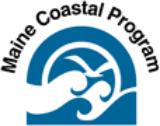
Lincoln County Sea Level Rise
Lincoln County Sea Level Rise - Coastal Hazard StudyLincoln County Regional Planning Commission
|
The Lincoln County Sea Level Rise – Coastal Hazard Study was conducted jointly by the Lincoln County Regional Planning Commission (LCRPC) and the Maine Geological Survey (MGS) with support from the Maine Coastal Program. The purpose of the study was to determine the potential impact of increasing sea level on the county’s 450 miles of tidal shoreline. There is clear evidence that sea level has increased in mid-coast Maine over the past hundred years. There are also strong indications that the rate of increase has accelerated over the past two decades and that sea level will likely continue to increase in the foreseeable future due to environmental factors. What is not known, however, is exactly how much sea level will rise or how it will potentially affect public infrastructure such as roads and culverts or public and private structures?
LCRPC and Lincoln County applied for and were awarded a grant to evaluate the impact of changing sea levels within 14 of the county’s coastal communities. Peter Slovinsky of the MGS was the principal scientist overseeing development of 10 sea level rise scenarios. In summary, the study examined the impact of 0.3 m (1-foot), 0.6 m (2-foot), 1.0 m (3.3-foot) and 1.8 m (6-foot) increases in sea level on the highest annual tide (HAT) as well as the “storm of record”, which for Lincoln County was the February 1978 storm, which resulted in the highest observed stillwater elevations along the Maine coastline. The storm combined an approximate 3.5 feet of storm surge with astronomically high tides.
While the results of the study will be presented individually to each community, the LCRPC determined that they should also be readily available in an easily accessible format to all residents and property owners in Lincoln County. For those who already have Google Earth on their computer, click on one of the following towns, open it with Google Earth and follow the instructions (data for each community will only be available after it has been presented to the community’s board of selectmen). For those who wish to install Google Earth click here. The scenarios are also viewable in Arc Explorer, click here for download and instructions. (Please note that if you are using a Mac, you will be limited to Google Earth.)
In addition to the scenarios, PDFs have been prepared for each community presenting predicted inundation depths for selected scenarios in selected locations as well as summaries of public roads and infrastructure predicted to be impacted individually and cumulatively under each scenario.
Scenarios are currently available for the following towns. Additional towns will be made available later this summer.
Boothbay
Boothbay Harbor
Bremen
Bristol
Damariscotta
Edgecomb
Monhegan
Newcastle
Nobleboro
South Bristol
Southport
Waldoboro
Westport
Wiscasset
100yr Flood and Highest Annual Tide Elevations Spreadsheet - download
Scenarios can be used in a variety of software applications, the most common being Google Earth and Arc Explorer.
Instructions for Google Earth
Instructions for Arc Explorer

